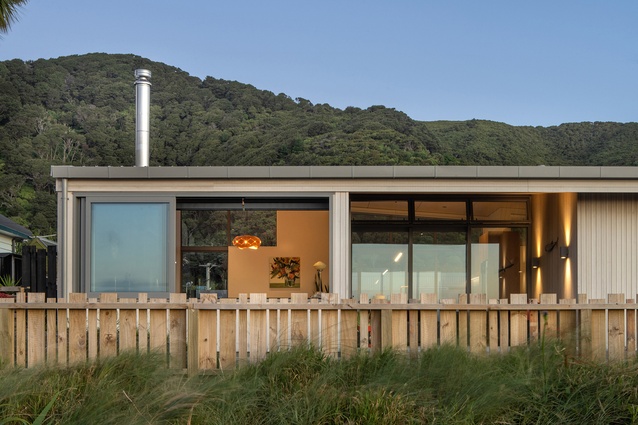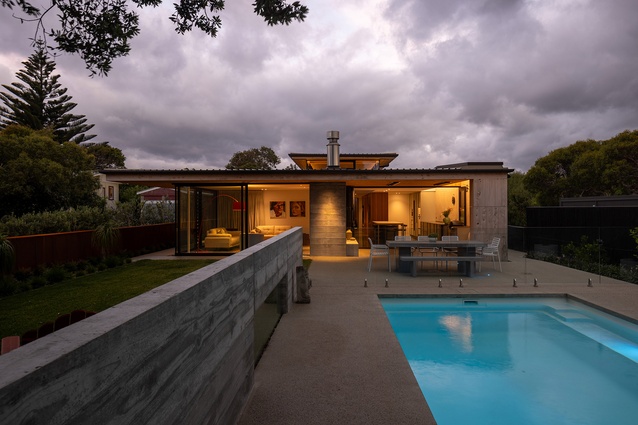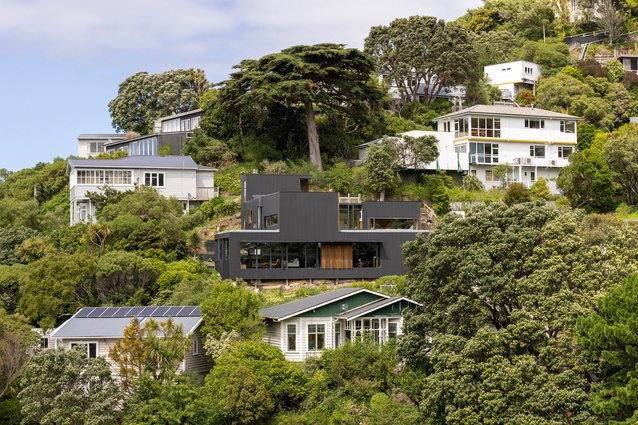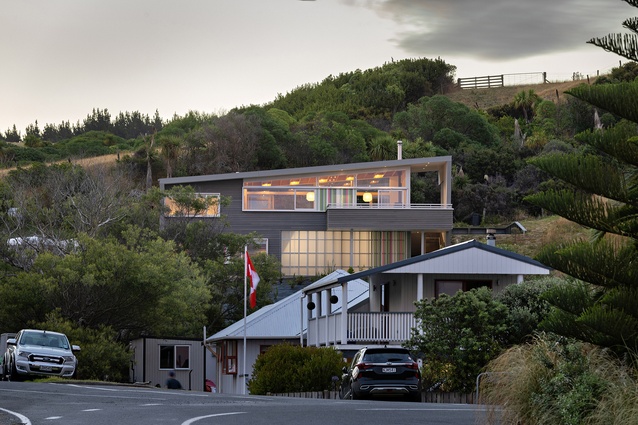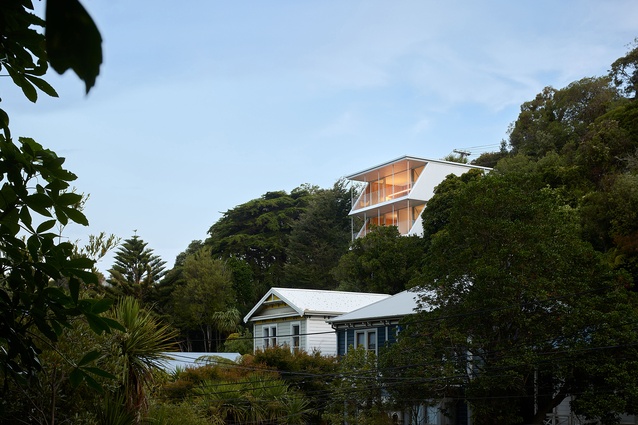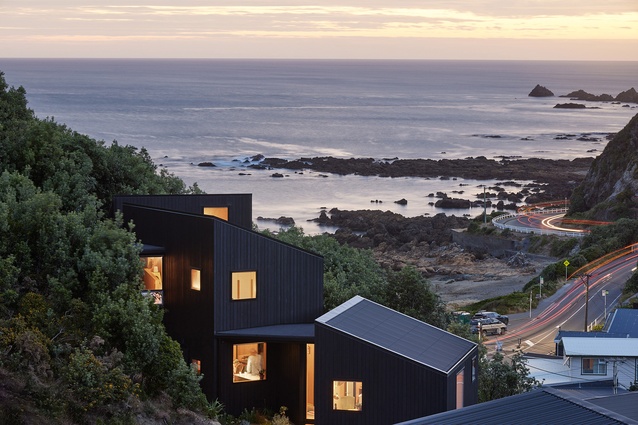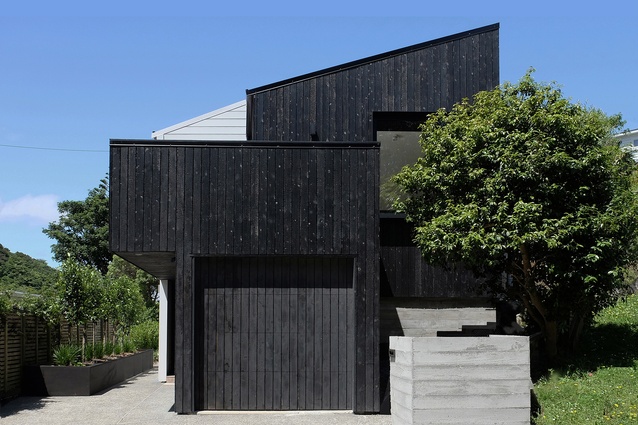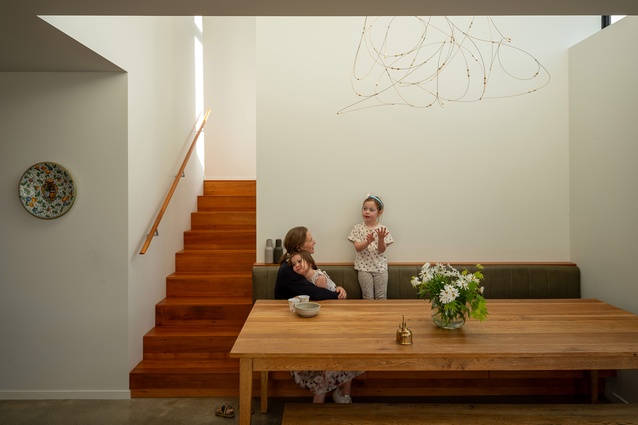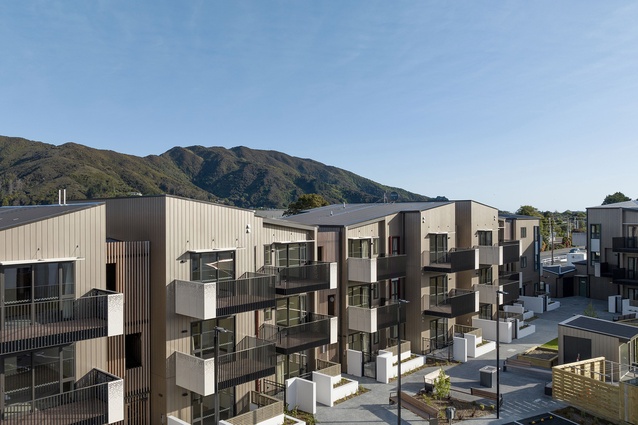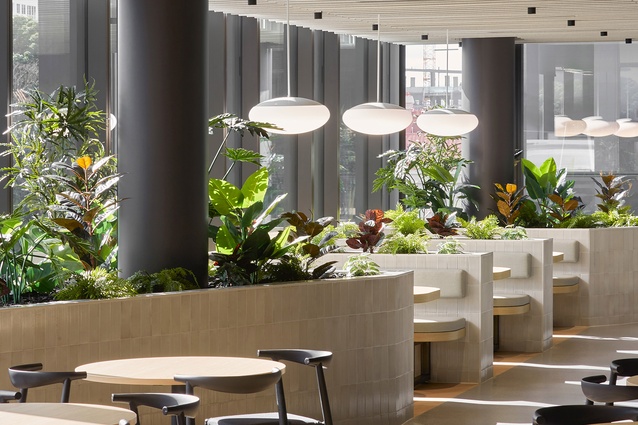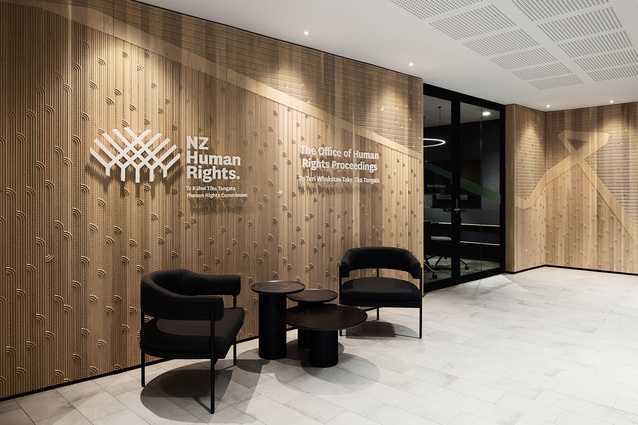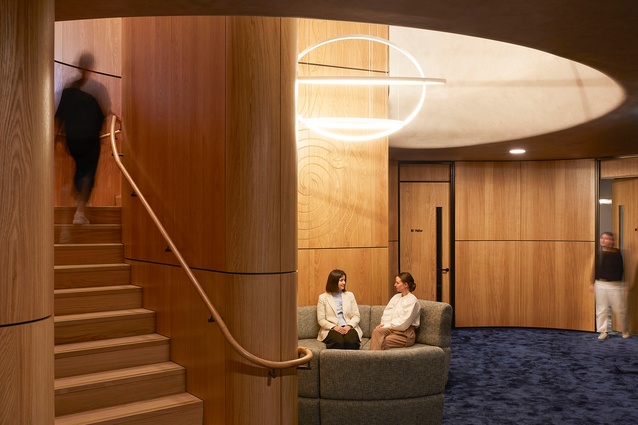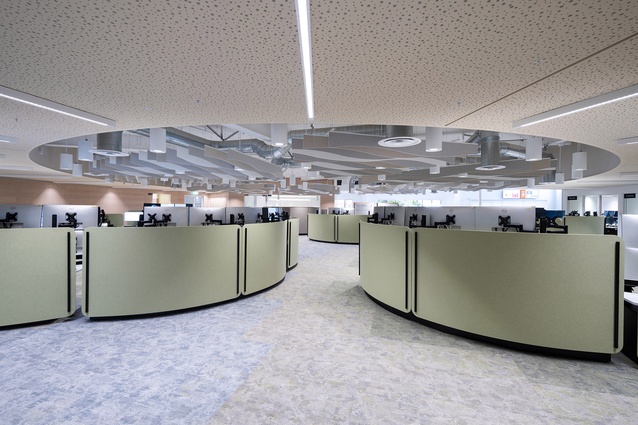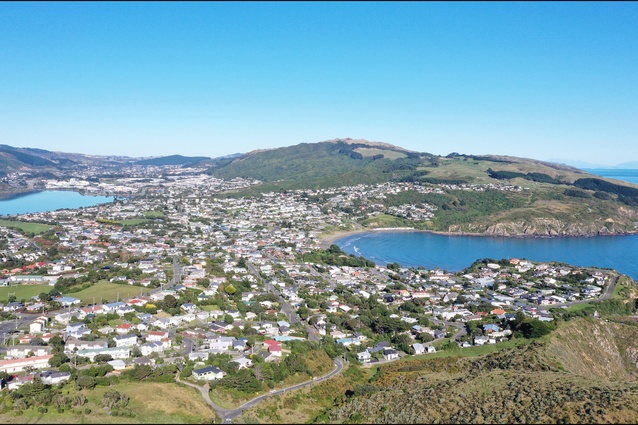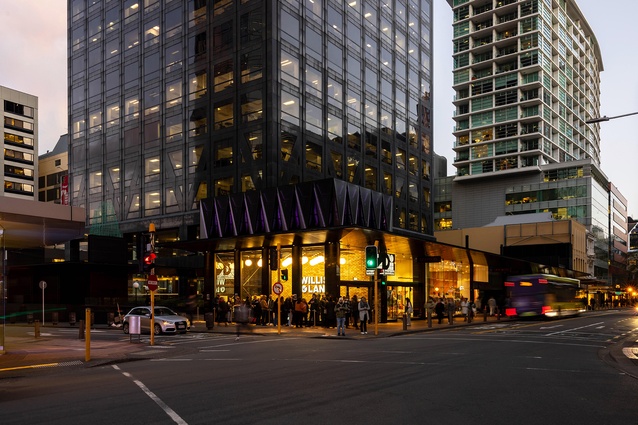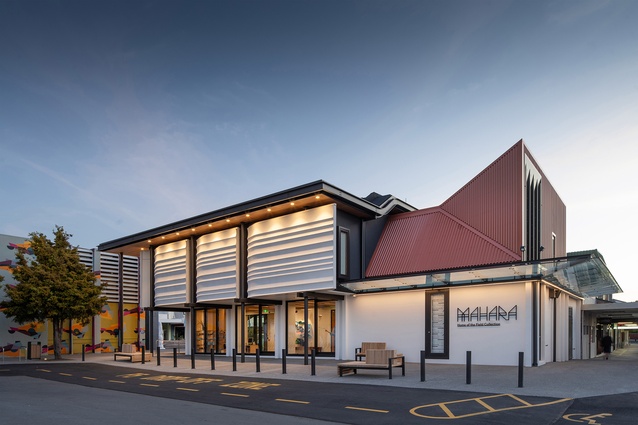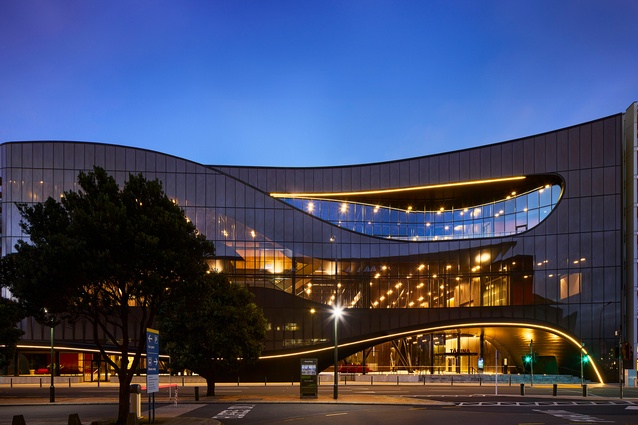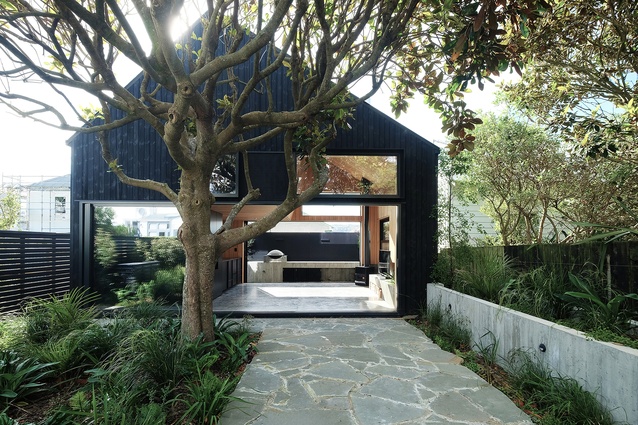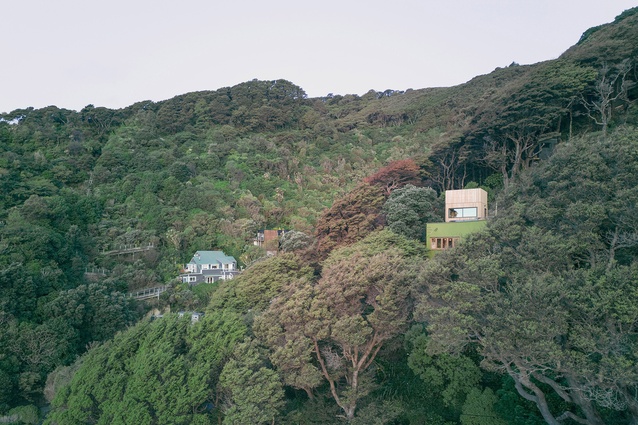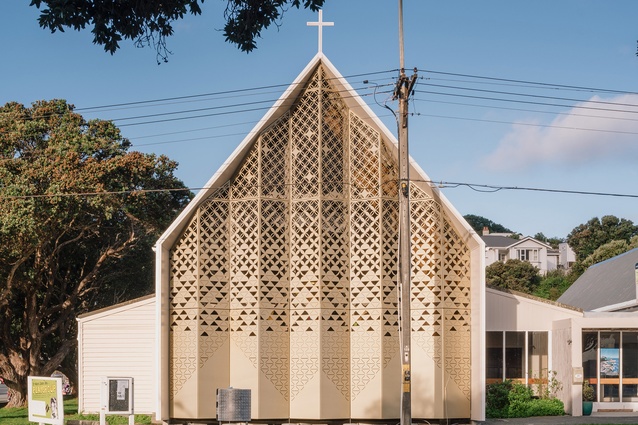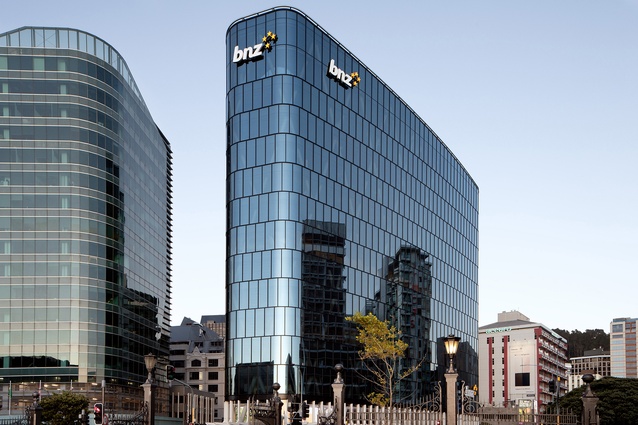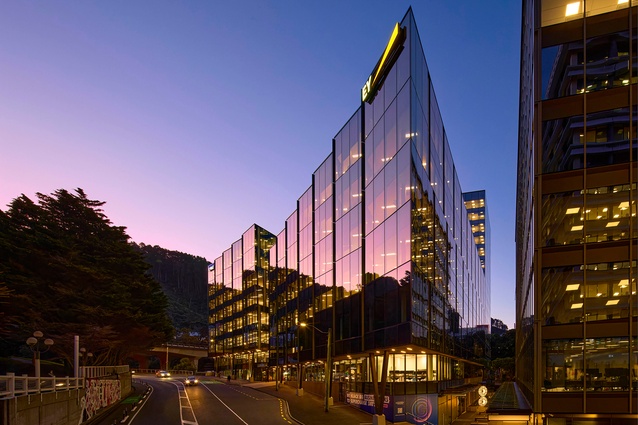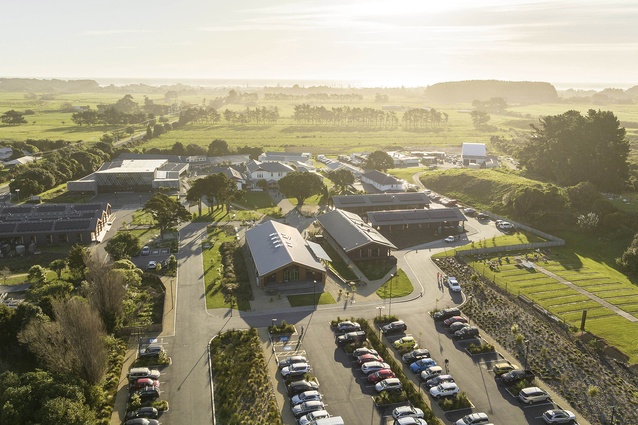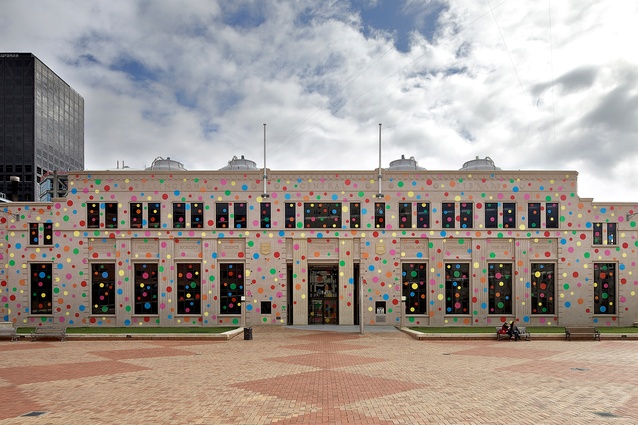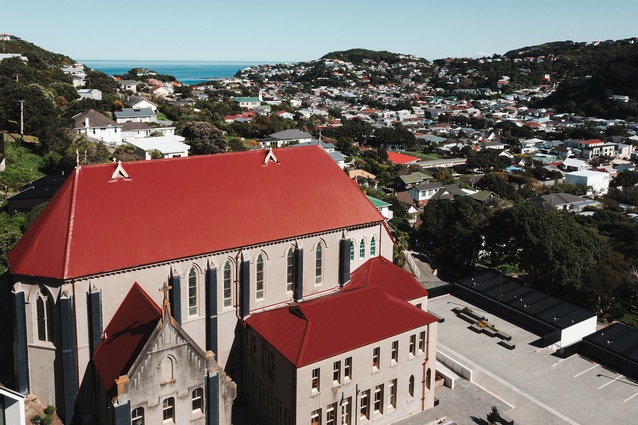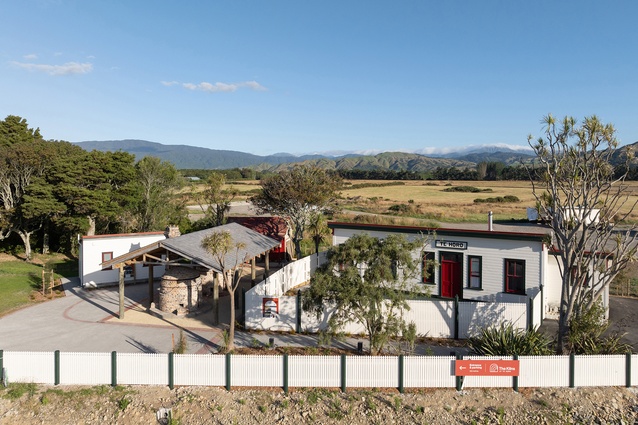Winners revealed: Wellington Architecture Awards 2024
A home for snow leopards, inner-city public housing complete with in-house support services, and three tiny projects are among the winners in the Wellington region’s Te Kāhui Whaihanga New Zealand Institute of Architects Local Awards.
Twenty-seven outstanding projects took home awards at an event held at the St James Theatre on May 23. The Commercial, Education and Public Architecture winners run the gamut, from a revamp of Te Horo train station to Architecture Workshop’s Snow Leopards’ Enclosure at Wellington Zoo, which includes dens, sunny perching areas and an outdoor space for the big cats.
Pā Reo Campus, an addition to the Wānanga in Ōtaki by Tennent Brown Architects, was lauded for being a certified Living Building. It shows “how the architectural process can be an advocacy tool for buildings that operate as cleanly, beautifully and efficiently as nature’s architecture”, says the awards’ jury.
St Hilda’s Church Renovation by First Light Studio has been awarded a Small Project Architecture award for its imaginative solution to earthquake strengthening. The new façade, a perforated screen, “has become a compelling urban feature that the wider community can enjoy”, says jury convenor, architect Mary Daish.
“These new buildings have brought elegant forms to streets, responded to the site and context, created new pedestrian experiences and connections, referenced the existing urban fabric, and made connections to the natural landscape too,” Daish adds.
There were 20 entries in the Housing category this year, with six being named winners, as well as two in the Housing — Alterations & Additions category.
“All entries demonstrated how architects design excellent bespoke homes, using skills and imagination to meet a client’s brief and providing a home that will last a lifetime,” says Daish. “The winning projects went further and engaged in an unusual design process or established relationships that went beyond the singular built form of a house.”
Oxford Terrace by Solari Architects was the sole winner in the Housing — Multi Unit category for its “highly empathetic design response — a heart-warming example of a community housing project,” says the jury.
The panel of judges also included Natasha Markham of MAUD, Stephanie Gardner of HMOA, and Beth Cameron of Makers of Architecture.
The winning projects are:
Housing
Pukatea Beach House by First Light Studio and FLiP Homes
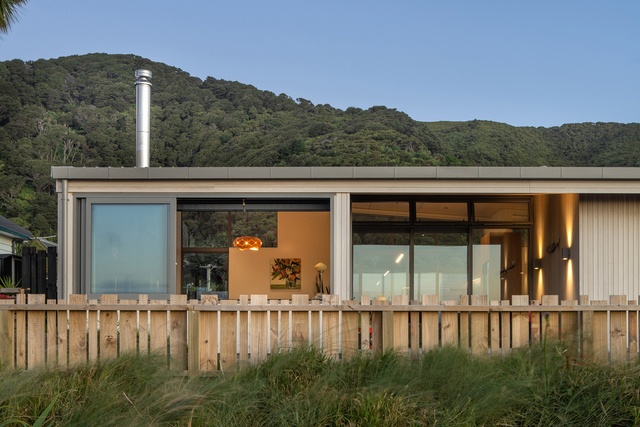
Not only have the architects provided two comfortable, delightful homes that consider the site and aspect, but they have also helped the client develop a strategy for her site. The ‘FLiP’ house, a prefabricated prototype, provides rental income, and in her own home, the client has a dedicated area to run her dog-grooming business — these lucky hounds have a ‘groom with a view’. The original retaining wall of the previous house creates an interesting textured landscape feature between the two dwellings. The main home addresses the very public beach front with carefully considered planning, window placement and recessed outdoor living areas. The bush-clad hills to the east are framed through high-level windows and, combined with a deck and sliding doors, allow morning sun to fill the living space.
Waikanae Beach House by Andrew Sexton Architecture
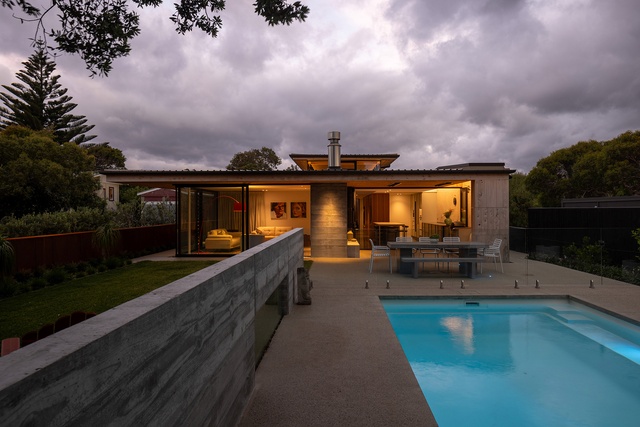
A rich palette of natural materials brings warmth and tactility to this new beach home. The exterior is softly patterned in lusitanica screens, shingles and siding, designed to weather in place. The interior unfolds as a series of spaces that change in degree of enclosure and volume, providing views within and beyond the building. This spatial dynamic allows the home to cater for different moods and numbers of people as demands require. Generous where it needs to be, the home embodies a sort of low-key luxury appropriate for its coastal locale.
Sar Street House by Parsonson Architects
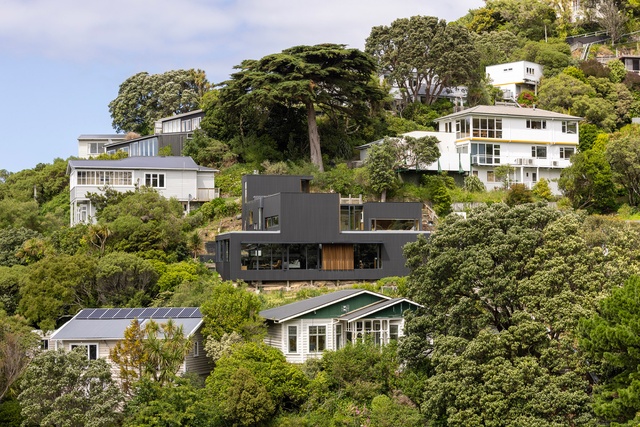
The design for this new home responds to its location within a community enclave, the opportunities and challenges of a steep site with harbour views, and a desire to explore detail and craft. Located 30 metres above the street, the approach presents an introduction to the neighbourhood, which the architect celebrates and enhances. Entry to the home proper is fittingly informal: past a courtyard that invites pause when doors are open and fire aflame.
Living areas are strung out on an east-west axis connecting to harbour views and the wider cityscape at one end, hunkering into that arrival courtyard at the other. This tension between grounding and extension informs the design at all levels and is exemplified in the interiors, which are highly detailed yet organic and informal.
Riversdale Beach House by Parsonson Architects
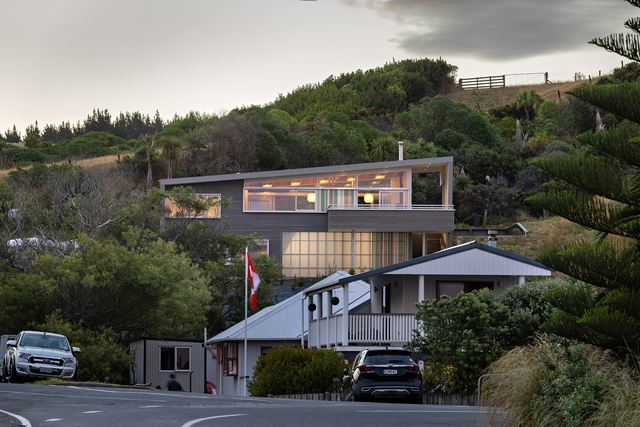
Back in the 50s, Basil Bodle had a vision for the Riversdale Station to become the Côte d’Azur of south Wairarapa. With its distinctive colours and stylish lines, Riversdale Beach House fits Basil’s aspirations. The roof overhang and angled side walls are inspired by Derek Wilson’s 1956 Maunsell beach house — Parsonson’s contemporary take links to those modern times and speaks to the New Zealand vernacular. The multipurpose under-croft form of the ground floor provides spacious storage, a protected entry to guest accommodation and a covered parking. Cheerfully coloured screens provide extra security to close off these spaces when not in use. The sliding screens give an elegant skirt to the L-shaped house above. The upper-level arrival provides carefully framed coastal views and the main living space soaks up all-day sun. The sheltered courtyard is a welcome respite from the wind. Inside, timber-framed panelling provides modulation and a sense of rhythm to the expansive sloping ceiling.
Resene Colour Award
The neutral tones of the façade are finely balanced by an enthusiastic colour palette. Outside, bands of pink and green are used in strategic locations where they are exposed to the sun. Inside, purple, blue and green are used for darker transitional spaces and bathrooms. The colour choice and detailing of the bathroom tiles further enrich the interior experience.
Raroa House by Patchwork Architecture
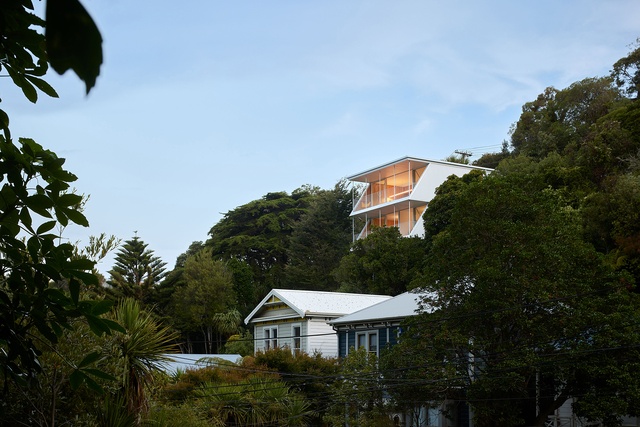
A clear and innovative planning response to a steep and challenging Wellington site, this home draws inspiration from Mid-Century Modern references, utilising exposed structural bracing to open the front of the home and connect it with the environment. Triangulation of the deep balcony walls creates both a sense of protection and geometric joy. This playful simplicity runs throughout, with green Marmoleum flooring, terrazzo benchtops and earthy bathroom tiles. Generous exterior covered spaces are experienced on both levels, allowing protection from the elements, off-street parking, laundry drying and grounding connection points with the sloping topography.
Houghton Bay House by Patchwork Architecture
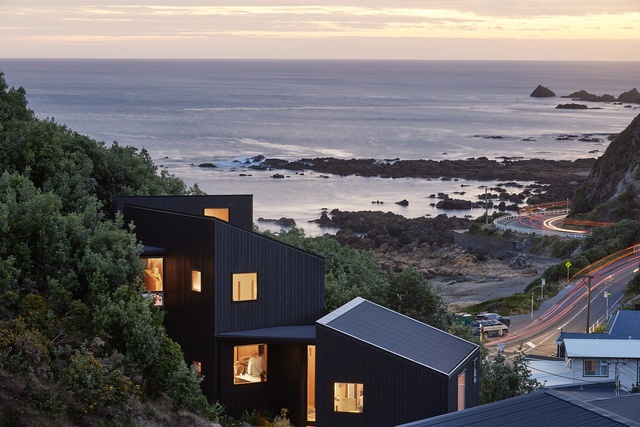
Amid a sea of new and exuberant homes, Houghton Bay House presents a quiet and assured proposition to building in the suburbs. Organised as a cluster of buildings, the stepping and rotating forms allow the home to negotiate a steep site while, at the same time, creating spaces within and between the buildings. This arrangement delivers a home with spatial richness and allows flexibility in the way it is occupied. Windows of the same proportion but different scales animate the façades and connect occupants with their surroundings through carefully framed views.
Resene Colour Award
Selective use of colour adds just the right amount of irony in this considered family home. From the entry stairway to a meandering wall of cabinetry, colour guides you through spaces and provides a playful counterpoint to rich ply linings and composed apertures. The choice of tones provides a subtle reference to the landscape and adds joy and delight to the interiors.
Housing - Alterations & Additions
B House by a.k.a Architecture
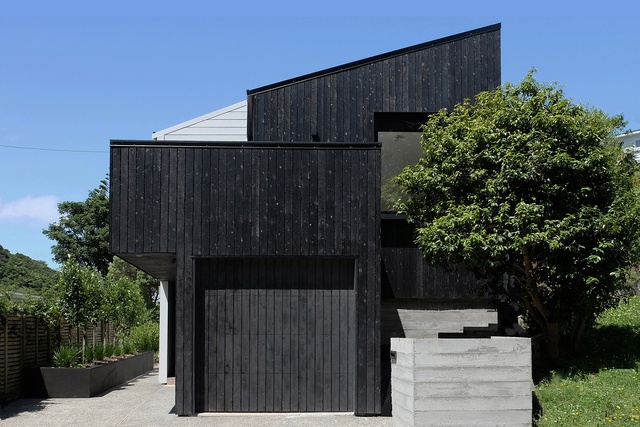
With focus given to creating generous and usable living spaces, this carefully sculpted design brings a new identity and life to a family home, while also referencing and retaining much of the original 1970s house. A new deck doubles as cover at the entrance. In the kitchen and living area, the inspired dropped and folded ceiling articulates the space and accommodates structure, discrete lighting and connection of the new sculptural addition. A framed window seat connects the living spaces with the neighbourhood and is articulated on the exterior to compliment the striking assembly of black forms. A wonderful example of minimal architectural intervention for maximum effect to achieve generous contemporary family living.
Wadestown House by Andrew Sexton Architecture
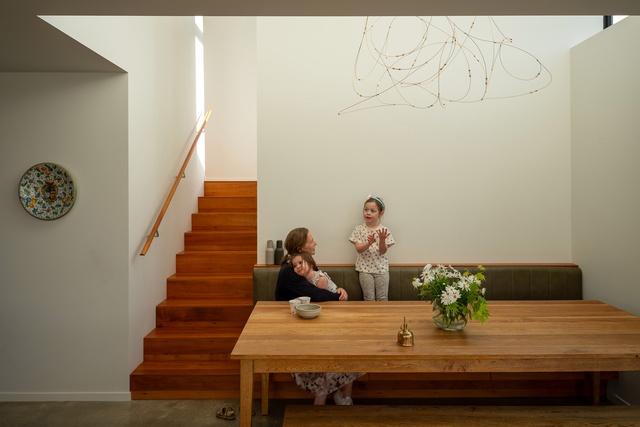
A villa renovation and extension accommodate the needs of a growing family now and into the future. Clever architectural thinking considers the steep site and aspect, creating intriguing, sun-filled volumes with new living, dining, kitchen and utility areas. Progression from the street through the existing villa and down the stairs to the new family areas is a sophisticated strategy of three-dimensional play. New windows frame the bush views beyond and successfully interlock old and new. Delight is brought to everyday living, with a morning courtyard providing an outdoor room, and the over-height glazed Douglas fir window frame providing depth, richness and a playful place to perch.
Housing - Multi Unit
Oxford Terrace by Solari Architects

A highly empathetic design response, from site planning to shared stairways, has resulted in a public housing project that allows a sense of community for single-person occupants. Generous and carefully positioned balconies enliven outdoor areas and allow residents to connect in informal ways. The balconies overlook a large central outdoor area that offers places to sit, gather, garden and socialise. Courtyards with garden beds provide texture and depth to the edges of shared spaces. Material selection, such as timber screens in the stairways, have been carefully considered to give public areas texture, warmth and durability. A heart-warming example of a community housing project.
Interior Architecture
Waka Kotahi NZ Transport Agency National Premises by Designgroup Stapleton Elliott
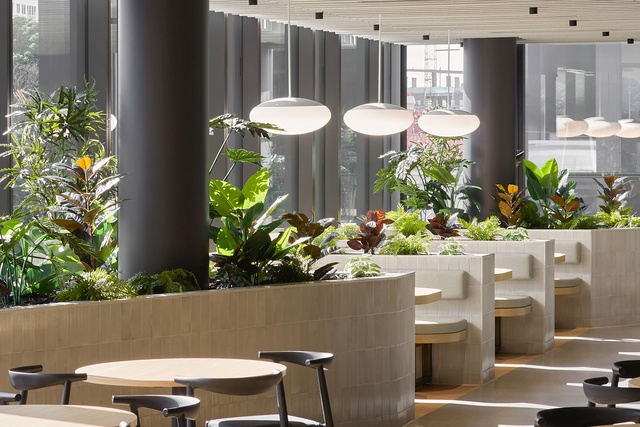
The fitout embraces views to the motorway, parking areas and busy Bowen Street, a location that represents what this agency is all about. The architects have kept the interior floor plates uncluttered, providing natural light to workspaces. Meeting rooms cleverly act as a buffer between the open-plan layout and support facilities. Base build materials and finishes are relied upon, carpet tiles accent key areas and shelving maximises space and light. Patterned CNC-cut acoustic panels, combined with bespoke joinery, provide a strong sense of place and identity. Concept delivery weaves its way with subtlety in a coherent choice and application of materials. Through robust reversed briefs to the client, the architects have delivered a honed result that is generous, makes good use of the budget and doesn’t compromise sustainability, earning it WELL certification.
Te Kāhui Tiki Tangata - Human Rights Commission by Designgroup Stapleton Elliott
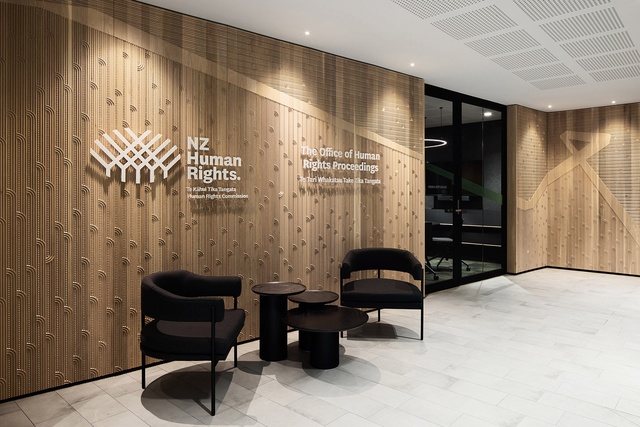
The complex brief required a sensitive design approach to consider potentially stressful situations. The clear architectural strategy has achieved a welcoming and non-confrontational environment. The architectural language, co-designed with mana whenua Te Atiawa Taranaki Whānui, conveys dignity. A unified aho, or thread, connect embellished interventions that depict the spiritual journey of new life. Progression and purpose are clearly addressed. Carved panels at the entry provide a moment of pause and reflect, before moving through to more concealed areas. Floor-tile patterns generate wayfinding and tactile acoustic screens that are rich in unify and connect spaces. A very human-centric interior that engages and calms on a sensory level.
Resene Colour Award
Colour is skilfully applied to embellish the interior with storytelling and provide clear wayfinding. Acoustic screens are embossed with colourful designs that invite tactile engagement and evoke the concept of mauri.
KPMG Wellington by Warren and Mahoney Architects
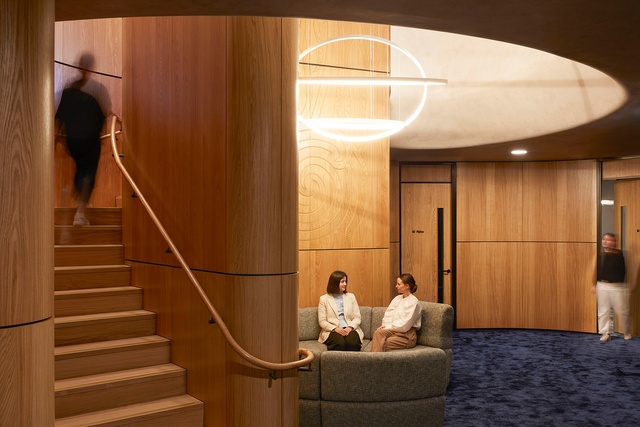
This fit out presents a unique identity, journey and supports a generous range of relaxed spaces for working and meeting. The richly textured and sequenced entrance welcomes all into a series of pocketed and embracing lounge-like spaces. The cultural narrative connects this space up the sculptural stair to the level above, opening into a multi-use, light filled and spacious kitchen. Flexibility underpins this common space — it can host large gatherings and a range of meeting and working opportunities. Open-plan workstations are positioned to provide views to the bush-clad Te Ahumairangi, Tinakori Hill.
Wellington Train Control Upgrade Project by WSP Architecture
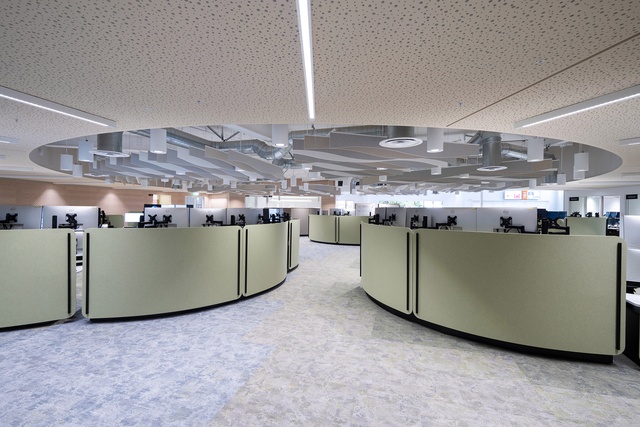
In-depth research and analysis of human-factor design has resulted in a fascinating workspace centred on the daily interactions of the train controllers who keep our railway network safe. In a potentially stressful environment, skilful design achieves high acoustic performance and visual connection between the controllers’ dedicated areas. Acoustic panels meet the quality and seismic performance required, while simultaneously creating strong architectural gestures, such as suspended ceiling clouds. Custom-designed workspaces accommodate specific requirements, such as large sheets of train schedules, resulting in an engaging curved, fluid interior. Early consultation with the base-build architects has ensured that high-level windows bring in natural light and views. This deceptively simple, serene and sophisticated environment is the result of in-depth research, which deserves recognition.
Resene Colour Award
The landscape that the national train network navigates is referenced through colour and material selection. Timber panelling, muted greens, calming blues and soft greys evoke the panoramic scenes of a train journey, while creating a calm, elegant workplace.
Planning & Urban Design
Te Āhuru Mōwai Vision Framework by Isthmus Group
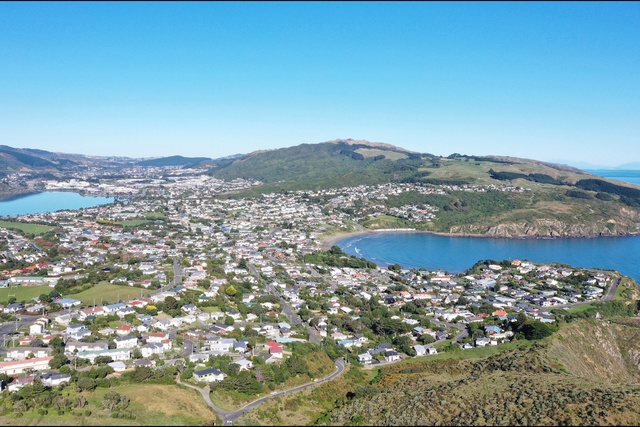
This living document represents an extensive research and co-design process encompassing a breadth of considerations — from landscape dynamics to socio-economic factors — and demonstrates profound consideration for the individuals it directly impacts. The project provides a roadmap to wellbeing for communities in Porirua, with access to quality housing and urban development grounded in te ao Māori principles. A central part of the co-design process was the innovative use of personas, placing individuals and their diverse needs squarely at the heart of planning decisions. A range of opportunities are described through approachable graphics that draw on wholistic concepts of wellbeing, sustainability and circular economies. This human-centric approach promotes inclusivity and fosters a deeper understanding of the intricate fabric of the communities it serves.
Willis Lane by Tennent Brown Architects and Izzard Design in association
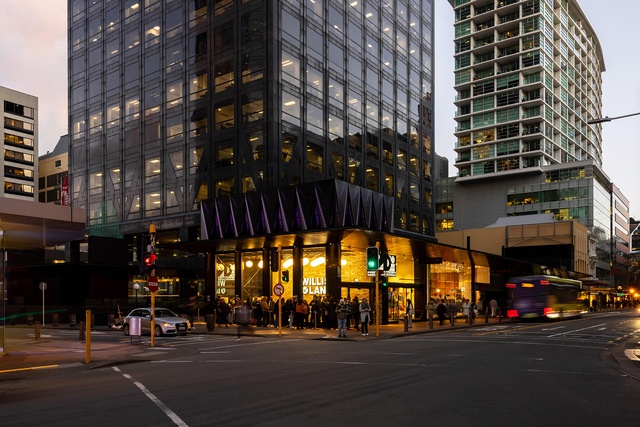
The project involves a series of transformative works to an important part of the city. Seemingly small interventions streetside belie an extensive remediation project below ground, which transform neglected retail into a hospitality and entertainment destination. Converting what was once a blank façade into an active corner building — replete with party hat — the project now celebrates this significant intersection of Willis Street and Lambton Quay. This new city marker provides entry to a revitalised subterranean precinct and is supported by an enlivened second entry on Willis Street. Fine-grained details demonstrate an astute understanding of how to leverage broader public benefit from a discreet number of moves. The project anticipates further development in this part of the city and signals expectations for the delivery of quality public interfaces.
Public Architecture
Wellington Zoo Snow Leopards Enclosure by Architecture Workshop

The architects have successfully juggled the spoken brief and silent needs of all involved in this project. The snow leopards seem to relish their new environment, leisurely sleeping on the sheltered purpose-made dens, providing visitors with the experience of seeing these majestic creatures up close. Perching areas give a more distant view and allow privacy for the animals, on their own terms. The enclosure’s hard landscape is sustainably built, reusing the old sun-bear enclosure materials as fill, minimising waste removal in line with the zoo’s sustainability goals.
The paramount safety of the zookeepers is integrated into the design. Black steel mesh, a key safety feature, and its supporting structure anchored in precast buttresses, is cheerfully detailed with snow-leopard markings. The project, designed through the Covid period, speaks to the animals’ native landscape, while anchoring the visitor experience here in Te Whanganui-a-Tara and the country’s oldest zoo.
Toi MAHARA by Athfield Architects
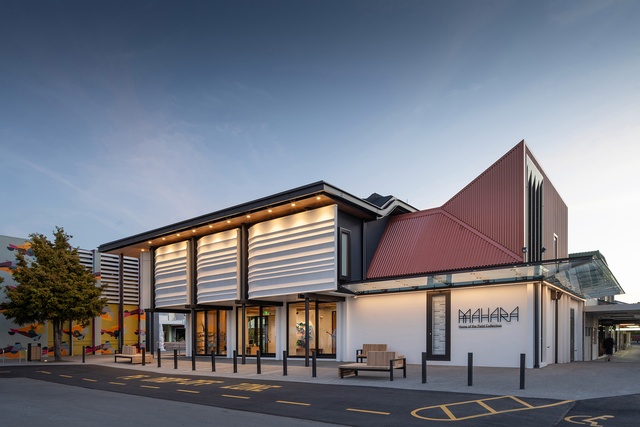
The reworking of the original Waikanae Library building, designed in 1976 by Gabites, Alington & Edmondson, transforms it into a home for the gallery and archive, creating a cultural cornerstone that anchors Mahara Place. A series of architectural interventions deliver a new identity and acknowledge the geographic and cultural location. Central to the scheme’s success is a series of flexible spaces within a compact footprint. Despite its modest size, versatility allows the gallery to operate as a dynamic hub. The renovation supports operational cost efficiency, recognising the importance of financial sustainability for a small organisation. This thoughtful redesign not only revitalises the gallery, but also anticipates the rejuvenation of Waikanae’s civic heart, positioning it as a catalyst for urban revival.
Tākina - Wellington Convention and Exhibition Centre by Studio of Pacific Architecture
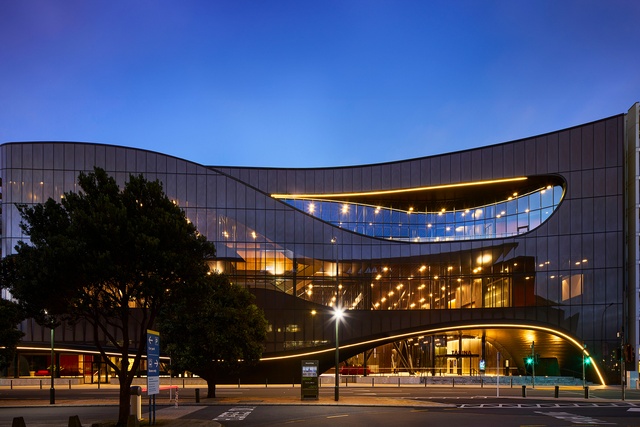
The design for this new centre demanded a complex range of responses. Alongside commercial aspirations, the centre needed to operate at a range of scales, be identifiable as a building of national significance, while also fitting in with its surroundings. Tākina manages all this and some. The curvaceous form responds to the site’s geometry and is informed by its maritime setting, Māori mythology, and the winds that give rise to the building’s name. Sinuous curves to both entries extend an invitation to enter. Inside, complex programmatic requirements are managed through a rational plan for flexible use. Plenary spaces enjoy natural light and outlook, and interior legibility demonstrates the architect’s thorough consideration of the user experience.
Resene Colour Award
Subtle yet significant use of colour is applied throughout the building design. Tones range from earthy to mineral and evoke the natural landscape. From carpet tiles to walls, colour defines spaces and gives legibility to access routes and services. The result is a building that reads intuitively for its users.
Small Project Architecture
Austin Pavillion by a.k.a Architecture
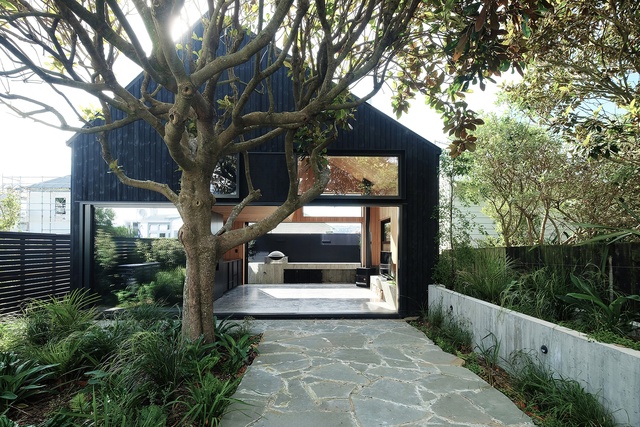
The pavilion is an urban sanctuary for the clients and their teenagers. Access to this meticulously crafted jewellery box is via the garden, which also serves as an outdoor room.
The architects have achieved privacy, despite the site being surrounded by five properties, and the concept of being at one with the garden has been met. The well-proportioned pavilion is anchored into the site with landscaped concrete walls and a polished concrete floor. Resolving a services challenge, the garden doubles down as a soakage pit to alleviate the lack of public stormwater. Futureproofing is also resolved as the pavilion could one day become a dwelling.
Karaka Tower by Arête Architects
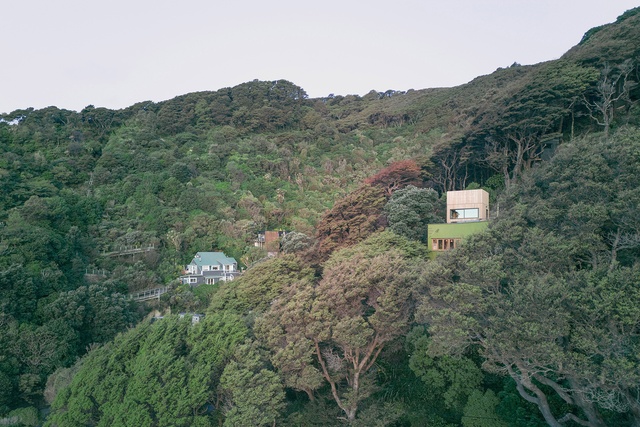
Walk-in access and steep bush-clad topography informed the tower’s verticality and clever prefab construction delivery. The detached structure — adjacent to the existing home — exemplifies how additional space can be conceived as an auxiliary. Minimal in footprint, it serves on many levels: providing much-needed extra living space, a studio and roof garden with spectacular views over Eastbourne. The crafted timber structure is exposed and weaves its way through the project, adding depth and detail to the interiors, as well as providing shelving. A covered polycarbonate linkway connects the existing home and tower at entrance level.
St. Hilda’s Church Renovation by First Light Studio
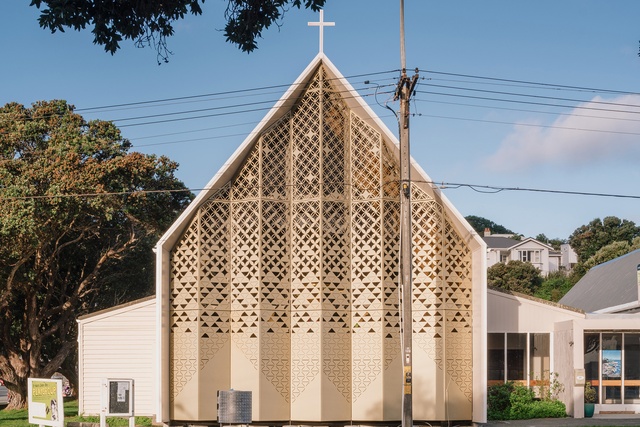
The façade treatment and extension address overdue earthquake remediation. Marked by the integration of beautiful curving new structural LVL portal frames, the extension successfully identifies as a modern addition. The inspired folded and faceted aluminium screening serves on multiple levels: to shield from the busy street and bring dynamism, warmth and filtered light to the interior. The abstracted geometric patterning has been inspired by the local Tapu Te Runga environment, referencing the coastline, island, sea, sky and stars. The project brings a modern identity to the church, its community and visibility within the wider community.
Commercial Architecture
BNZ Place by Jasmax
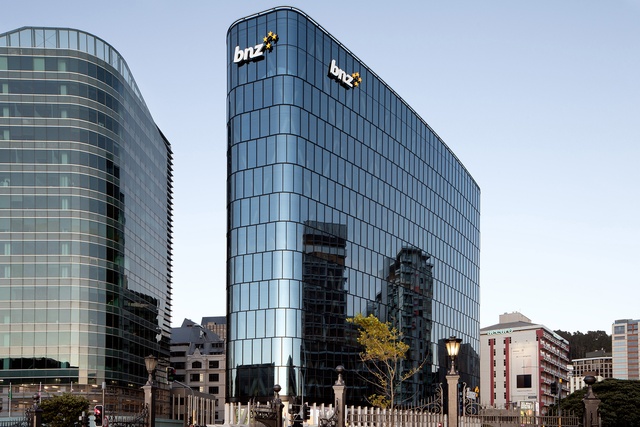
The building’s striking curved form speaks of the elemental location and triangular site.
At ground level, the canopy structure skirts the building, delicately protecting pedestrians. A sense of permanence, tactility and sensitivity to scale run throughout the resolution, material selection and detailing of the canopy’s rhythmic pillars, referencing the structural detail of surrounding historic buildings. Comprehensive planning ensures generous facilities are provided, including the sculptural roof terrace — where the dynamic building form and spectacular outlook are experienced — and well-appointed end-of-trip facilities at ground level. The building commits to longevity through its quality and environmental resilience.
40 & 44 Bowen Street by Tennent Brown Architects
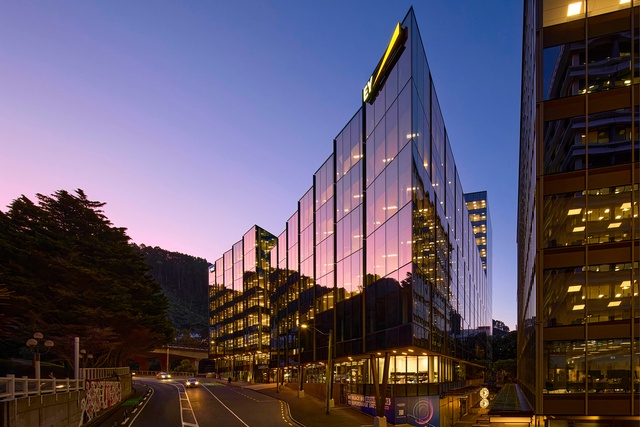
The project strategically addresses a key site left in disarray since the 2008 Global Financial Crisis. New life is given to the heart of the parliamentary precinct by creating two buildings that are braced against the old bones of Charles Fergusson Tower and Bowen State Building. Landscaped laneways connect to the giant Bowen Campus; its warm heart can be seen in the shared atrium of the new buildings. The double-height space, clad in timber and adorned with greenery, gives respite from the busy surroundings. The buildings carefully address all sides of the site, including the challenging Wellington Urban Motorway to the west. The Bowen St façade cleverly addresses the concave curve of the street, while the generous footpath improves the pedestrian experience. Finely detailed ‘fins’ add dynamism to the sawtooth façade, which is also reflected inside. The technological response to earthquake resilience is innovative and materials enhance sustainability, granting the building a 5-star Green Star rating.
Education
Pā Reo Campus by Tennent Brown Architects
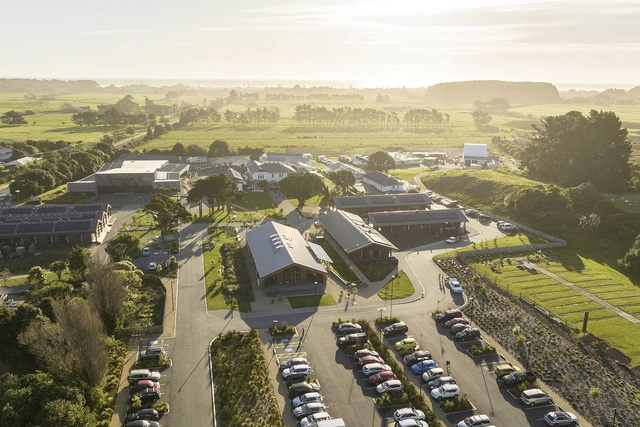
This significant project embodies kaitiakitanga to meet Living Building Challenge requirements, only the second to do so in Aotearoa. There is a ripple effect from the goal to create these self-sufficient and regenerative buildings — suppliers, contractors and subcontractors will take their learnings to other projects. The iringa kōrero, a back-lit patterned plywood canopy welcomes visitors with diffused light and directs them to the heart of the campus. The landscaping and strong gable forms that create a cluster of new whare are viewed as a cohesive system. The new te reo Māori ānake buildings are understated, yet elegant in their design intent and relate strongly to attenuated raingardens, water storage, plantings and plazas. Repeated forms create a sense of community. Timber decks, steps, ramps and seats weave and engage with plantings and plazas.
Enduring Architecture
City Gallery Wellington | Te Whare Toi (1992-1993) by Gardyne Architecture (now architecture+) with Wellington City Council
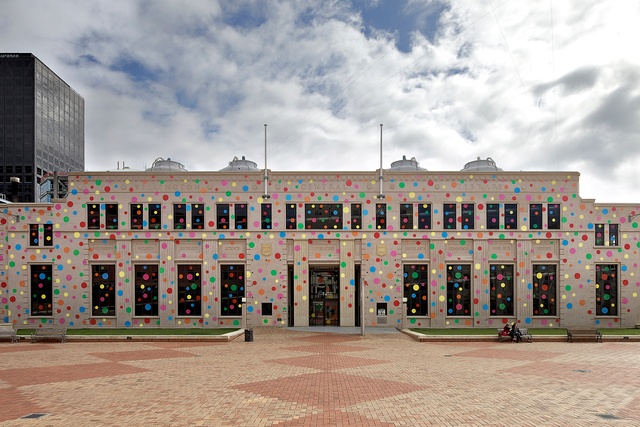
This highly successful adaptive re-use of an anchor civic building is the result of an architectural relationship spanning 30 years. The original project received a National Award in 1994. The editing strategy of the original 1930s classical architecture treats all new work as a distinct layer inserted into the original building fabric, creating a clear hierarchy of old and new, as well as rich spatial experiences. The contemporary layer is deliberately reserved and serene, spotlighting the art. Elegant proportions of the original library rooms are respectfully retained, as is the main stair. Later projects, such as the Adam Auditorium, Hancock, Dean and Hirschfeld Galleries in 2009, and the reconfiguration of the main entrance in 2017, continue this successful architectural process. They are a tribute to the commitment of Stuart Gardyne, which is to be celebrated as much as the building and its enduring presence at Te Ngākau, Civic Square.
Heritage
Erskine Chapel by Common and archifact-architecture & conservation
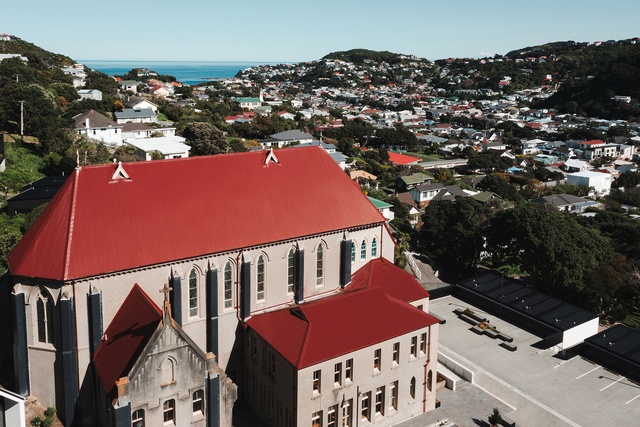
The Category 1-listed French Gothic chapel is a sentinel of older times. Located in the core of the former Erskine college building, the chapel’s interior is of great significance. The architects took a contemporary approach to the west façade and entrance — a minimalist intervention bandages the scar left by the removal of the old earthquake-prone main block. Major steel structural upgrades are semi unapologetic on the outside, but subtly integrated inside. A new roof allows the original brick-ribbed ceiling to remain intact and has been restored by master plasterers. Aside from steel, tonnes of high-strength grout was poured into the existing façade — a colossal strengthening effort to preserve the envelope. The chapel is located on the first level, where the restoration reaches a full crescendo of white arched ceilings lit by stained glass. No effort was spared to return the interiors to their original beauty, despite a decade of severe neglect. All project stakeholders should be proud of their contribution to this iconic building.
Te Horo Kilns: Station Building Restoration and Site Works by WSP Architecture
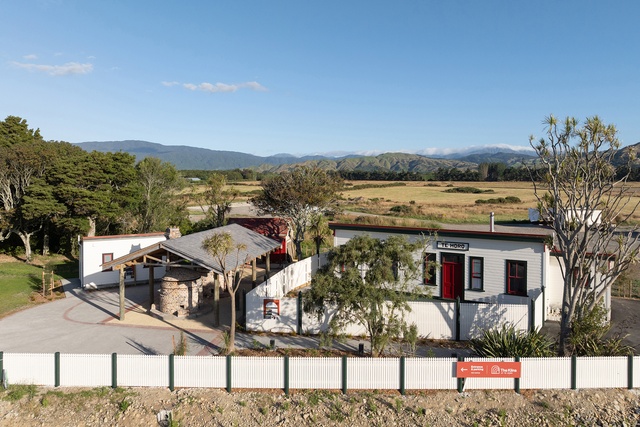
A careful strategy ensures the original Te Horo train station has been given new life, with the delightful scale and original architectural features restored. The station now sits proudly among an important collection of historic buildings and structures that form Te Horo Kilns. This project also preserves the legacy of Mirek Smíšek, one of New Zealand’s best-known pottery artists. A good example of collaboration by all stakeholders on a complex project. With shared intent, the result preserves a slice of history and provides an events space and art studios.
The NZIA Architecture Awards programme is supported by Resene and APL.

